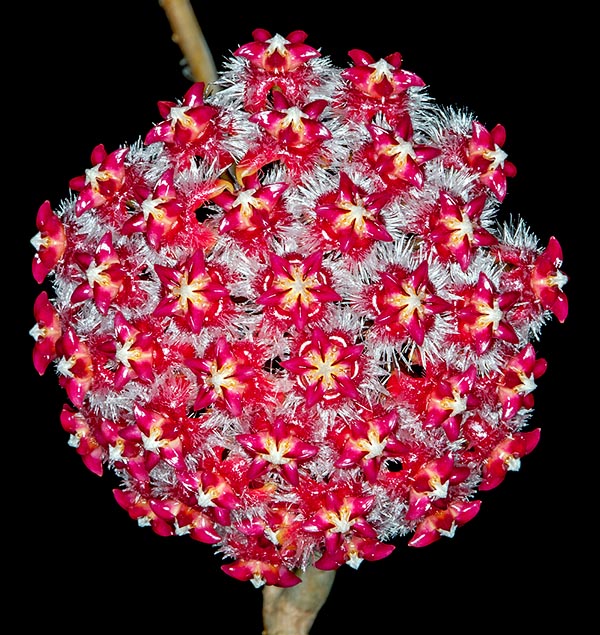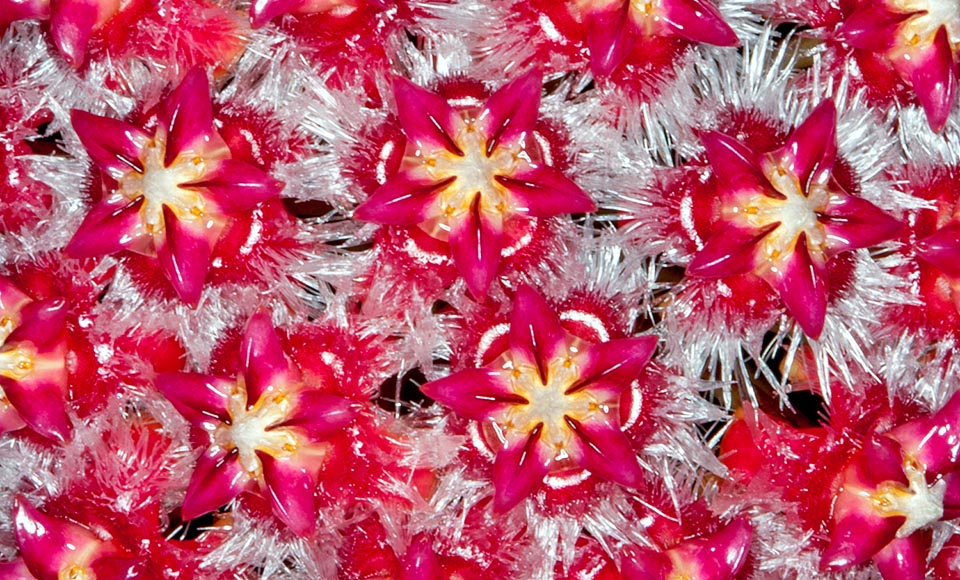Family : Apocynaceae

Text © Pietro Puccio

English translation by Mario Beltramini
The species is native to the Philippines (Mindoro) where it grows as epiphyte on the trees of the humid forests close to the water streams.
The genus is honoured to Thomas Hoy (ca. 1750-1822), botanist and curator of the gardens of the duke of Northumberland; the specific name is the Latin adjective “mindorensis” = of Mindoro, with reference to its origin place.
Common names: Mindoro hoya (English).

Epiphyte with adventitious roots, Hoya mindorensis grows on the trees of the Filipino forests © G. Mazza
The leaves, on a 2-2,5 cm long petiole, are opposite, simple, elliptic to oblanceolate with acuminate apex and entire margin, 7-12 cm long and 2,5-5 cm broad, coriaceous, glossy, of pale green colour that in condition of maximum luminosity get a reddish tonality. Axillar umbel inflorescences on a 2-3 cm long peduncle, of 8-10 cm of diameter, bearing up to more than 40 slightly perfumed flowers, of 0,9-1,2 cm of diameter, that last on the plant about one week. Five ovate lobes corolla with obtuse apex and auriculate base, retroflexed, of red colour, provided with bristly white translucent hairs and crown with 5 red acuminate lobes. The fruits are fusiform follicles containing several seeds provided at one extremity of a tuft of silky hairs that favour their dispersion by means of the wind. Have been selected cultivars with yellow and orange flowers.
It usually propagates by cutting, with 2-3 nodes, in very sandy loam or agriperlite maintained humid at a temperature of 26-28 °C, and by air layering, but the vegetative regrowth is usually slow. Less frequently it reproduces by seed, that does not have a long lasting germinability, in late spring, placed superficially on organic loam with addition of siliceous sand per a 30% maintained constantly humid, but without stagnations.
Name discussed on the taxonomical point of view, as there is no agreement among the scholars whether to consider it as accepted or as synonym. Vigorous and floriferous, it is one of the most characteristic of the genus due to the bristly white translucent hairs present on the lobes of the corolla, that stand out on the red of the same and of the corolla, cultivable in open air in the tropical, subtropical climate zones, needing averagely high temperatures and ambient humidity, in very luminous position, with filtered sun light, for an abundant blooming. Elsewhere, it can be cultivated in pot as climber, guided on appropriate supports, or as drooper on suspended baskets, to be sheltered during the coldest months in a location with high luminosity, even some hours of direct sun in the morning, and lowest temperatures preferably not under the 16 °C.

Umbel inflorescences, of 8-10 cm of diameter, with showy red corollas, perfumed, bristly of typical white translucent hairs © Giuseppe Mazza
→ To appreciate the biodiversity within the APOCYNACEAE family please click here.
